«previous pageRESEARCH CATEGORY
Honor Award
Restoration ecology processes to advance natural landscape design
Professor Steven N. Handel, Honorary ASLA, New Brunswick, NJ
Project Statement
Ecological services from restored natural habitats can enhance landscape design. Controlled experiments on urban landscapes, including landfills and brownfields, determined that woody species can thrive on thin engineered soils, but traditional hydroseeding must be modified, and diverse plant genotypes are needed for degraded sites. The surrounding landscape matrix contributes seeds and pollinators onto designed sites, changing the biodiversity trajectory, including non-native invasive habitat threats. These ecological links impact the future functioning of all urban landscapes.
Project Narrative
Problem
Most people now live in urban areas and need the ecological services supplied by natural habitats to support our communities. The potential to restore habitats into our urban centers is difficult, challenged by highly degraded conditions, small, fragmented parcels, and political conflicts in land uses. Landscape architects are increasingly interested in incorporating natural habitats into design schemes but the potential for restoring sustainable landscapes in these degraded conditions is poorly understood. Most ecological work has been done in rural or wild conditions, not urban centers. Pragmatic solutions are needed to make ecological restoration a functioning, cost-effective, and compatible element in our urban designed landscapes. The ecological target for practical restored habitats must be clear before design decisions can be made.
Methods
A wide series of field experiments on degraded urban lands has been conducted to define ecological processes important for restoring natural habitats in the stressful conditions. What are the ecological links that can be reestablished on parcels that are often surrounded by dense populations and extensive infrastructure zones? My lab addresses this by exploring experimentally two topics, first, the limits to initiating populations of native plants on degraded urban land, and second, the impact of the surrounding matrix landscape on newly restored habitats that are part of a designed landscape. These principles were then tested for their applicability to new urban parks by partnering with landscape architecture teams wanting to incorporate ecological restoration as integral elements of design schemes.
These studies were done on highly degraded urban areas within the New York - New Jersey metropolitan area, including sanitary landfills, brownfields, and isolated urban lots. These types of landscapes are common in urban areas and may have the potential to be sustainable natural areas if certain hurdles can be crossed. Restoration of woodland habitats on degraded soils such as landfills has been limited due to concerns regarding root penetration of protective caps. Traditionally, erosion control and waste management, the narrow management foci of these sites, results in degraded monocultures of hydroseeded alien grasses. In reality, landfills have the potential to be transformed into islands of biodiversity within urban centers. To test the compatibility of woodland habitats to landfills and other engineered soils, large series of native tree and shrub species were installed across the Fresh Kills Landfill, and a control series was installed in an adjacent deep soil habitat. Root dynamics were measured in both treatments after two years. Similarly another landfill was explored where natural invasion of 12 native woody species occurred over the past 9 years. The second landfill soil was less than 30cm deep over the clay cap. We tested the hypothesis that woody species could persist under constrained rooting conditions without compromising the integrity of the engineered cover.
In a parallel experiment we tested whether seeds of 27 native woody species could emerge and grow on a landfill that had been closed using the typical practice of high compaction and then hydroseeding with perennial grasses. We planted 15,620 seeds on the landfill and recorded emergence and survival for three years. If direct seeding of these native species were possible, then restoration of many closed landfalls to woodland parcels would be feasible and cost-effective.
Smaller urban habitats are stressful in many ways, including atypical soils that are hot, relatively sterile, polluted with concrete dust, salt, or heavy metals, compacted, or highly variable over very small scales. We tested whether special plant genotypes would be needed to survive conditions in degraded soils of urban areas using the common garden technique. Seeds of five herbaceous species were collected at degraded urban sites and also at a rural, post-agricultural site. These were grown into seedlings, and then out-planted in five urban test gardens. The experiment asked whether seed from urban provenances such as a landfill, a highway edge, or a railroad yard, would grow better in similar habitats than seedlings derived from non-urban sources. That is, has there been selection for plant performance at small-scales in highly stressed urban land? If so, then urban derived plants rather than routine nursery stock must be used as founders of new urban habitats.
Finally, all urban restorations are surrounded by modified and biotically degraded landscape matrices. To test the influence of these surroundings on the potential for sustainable new natural communities we studied which seeds and pollinators came into experimental plantings. To do this work we planted 20 patches of native trees and shrubs (Fig. 6), and then recorded what seeds were brought in by birds or the wind into traps in the test patches. Also, we sampled the bee community visiting flowers in our test patches and compared these pollinators to those visiting flowers of the same species in natural areas. To understand the changing plant species complex around urban parcels destined for restoration, we studied data from historic floras, 129 years old, in comparison to recent floras of Staten Island. We also revisited a suburban woodland well characterized 53 years ago and studied how the plant species had changed in response to new habitat stresses over this half-century.
To apply ecological principles based on our research, we subsequently partnered with landscape architecture teams to effectively rebuild natural habitat parcels within multi-use large public parks undergoing master planning.
Results
Initiating new populations
Roots of the woody species tested do not pierce landfill caps (Fig.1). Roots of naturally occurring woody trees that grew up to 5m in height did not reach deeper than a few inches above the clay cap. Our results support the conclusion that no conflict exists between increasing biodiversity through woodland restoration in an urban area and the need to protect the solid waste. In fact, woody plants become a bioengineering advantage of intercepting and transpiring water, lessening the leachate.
In the direct seeding experiment (Fig.2), only 1% of native seed emerged (Fig.3). Seedlings were suppressed by the high bulk density soil and competition from the total fescues. Traditional hydroseeding practice must be replaced by erosion control methods which allow ecological succession and a more comprehensive approach. Simply introducing new seed into soils for a specific engineering purpose is not sufficient for restoring landscapes.
Tests with seeds from urban genotypes of species showed that what is called "urban" is a collection of diverse habitats having different soil and microclimatic conditions (Fig.4). Seed from any one urban source cannot be predicted to grow well in another urban setting (Fig.5). Although the post-agricultural site showed the highest productivity and biomass among all genotypes tested, seed source performance could not be predicted on any one of the urban sites. Characterization of any one urban site is expensive and rarely possible during restoration planning. The most successful and cost-effective seeding scheme is a mixture of seed from different urban sources that allows natural selection to determine which plants eventually succeed on a specific urban site.
Influence of landscape matrix on fate of ecological restorations
Even when a restoration site is surrounded by industry or residential zones, the experiments show there is a complex interaction between these urban adjacencies and new sustainable plant communities. Experiments with seed deposition showed that thousands of seeds from dozens of species would be quickly carried in during the first few years (Fig.6). Biodiversity of woody plant species increased from the 7 installed to over 30 after two years. Nearby habitat remnants, ignored by development, are native seed sources spread by birds into new designed areas. A few species that appeared were alien species. These data show that rapid management of alien species is needed because they threaten the desired natives.
Tests for the reappearance of bees, as an indicator for the potential of restored plantings to reproduce and spread, were also positive after three years. Over 60 bee species appeared on flowers, even up to 350 m into the site (Fig.7, 8). The percentage of flowers that set seed was statistically the same as on plants of the same species in habitat reserves. This suggests that after the initial restoration, seeds are produced within the new site.
My lab's data show that the urban habitat matrix is suffused with alien species that can overwhelm native habitats. Our research into the changing flora of Staten Island over a century shows that the percentage of alien species is increasing in all major habitat types (Fig.9). Consequently all restoration designs must include management and monitoring plans that address new invasives until the preferred habitat becomes established. The focused study of 53 years of change in one old woodlot shows that significant change has occurred in all strata (Fig.10). Deer over-abundance and the alien plant species together yield a new habitat lacking the structure of 50 years ago. Use of local remnant habitats as vegetation models may be inappropriate due to the amount of invasion. Similarly, a study of the alien tree, Norway maple, demonstrates that these trees restrict the growth of native shrubs and saplings more than the native canopy trees (Fig.11). The dominating nature of Norway maple negatively affects restoration of biodiversity.
Conclusions and significance
Taken together these 15 years of experiments demonstrate ways that newly restored habitats can enhance ecosystem services of heavily degraded urban centers (Fig.12). A strong interplay exists between a site design undergoing ecological restoration and its landscape matrix. Planning for biodiversity and mutualistic relationships (seed dispersers and pollinators) will improve landscape design and insure sustainable habitats. Since urban areas are suffused with alien species, in all habitats, management and monitoring of native stands it is still required to prevent alien threats.
Application to landscape architecture practice
These findings have been applied to the master planning of new urban parks. At the Brooklyn Bridge Park of New York City, plans for new wildflower meadows, shrublands, and woodlands have been included (Fig.13). These experiments have informed this work by showing the success of many native species on urban sites with poor rooting zones. Also, use of urban genotypes will help secure a low-maintenance and successful future. Similarly, in California, the completed designs for the new Orange County Great Park include large areas that will be native woodlands, meadows, and sage scrub (Fig.14). These parcels are arranged in a mosaic so population expansion and contraction can occur over the decades as local climate conditions vary (Fig.15). The design goal is to create a dynamic landscape that reflects and illustrates natural ecological processes, instead of static plantings requiring intensive maintenance resulting in higher costs for the future.
Future needs
The rapid growth of urban centers throughout the world suggests that these kinds of urban restorations will be valuable to supply ecological services that can be managed on low budgets. Restoration ecology of diverse urban habitats provides added value in supplying less stressful urban microclimates, enhances biodiversity which allows for inevitable dynamics in species proportions, particularly important with ongoing climatic change. The joining of modern landscape design skills with plant community ecology will yield landscape parcels more valuable, persistent, and cost-effective than projects centered on aesthetic and recreational aims alone.
Project Resources
Research Facilities
Rutgers University Dept. of Ecology, Evolution, and Natural Resources Duke Farms Foundation
Greenbelt Native Plant Nursery
Special Thanks
George R. Robinson
Shannon Galbraith-Kent
Myla Aronson
Amy Long
Jessica DiCicco
Christina Kaunzinger
Mary Yurlina
Jennifer Mattei
William Parsons
Hadas Parag
Steven Clemants
Edward Toth
Ken Smith
Mia Lehrer
Michelle Sullivan
Milan Mitrovich
Mark Dawson
Alan Ward
Kate Orff
Michael Van Valkenburgh
James Corner
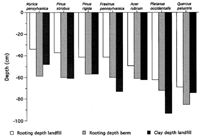
Roots do not penetrate clay caps: controlled plantings on landfills and adjacent deep berms show that caps resist root penetration, allowing for divers woody plantings on degraded urban sites. Woody plants are now allowed on area landfills, building ecological structure. (Photo: S.N. Handel)
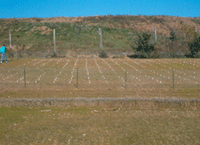
Direct seeding of 27 native woody species into landfills was tested in replicated test plots. Each experimental location contained seeds which must germinate, then emerge in the high bulk density soil and heavy fescue cover of a typical landfill closure. (Photo: S.N. Handel)
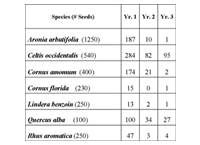
After 3 years, only 7 of 27 species in this experiment had any surviving seedlings, representing 4% of these "successful" native species. The possibility of building plant biodiversity through direct seeding will require a change in traditional closure engineering protocols. (Photo: S.N. Handel)
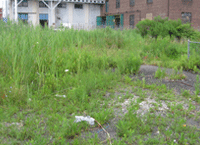
Urban genotypes of native herbs were collected in degraded urban sites, such as this lot in an old industrial zone. These seeds were grown in a research greenhouse, and then out-planted in diverse test plots throughout a metropolitan area. (Photo: S.N. Handel)
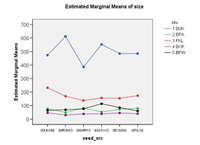
Seed sources did not show significantly different growth within any degraded urban restoration (garden) site. The rural garden supported high growth. DUK = Rural. DOP = Industrial fill. EPA = Brownfield district. FKL = Closed landfill. BPW = Highway roadside.
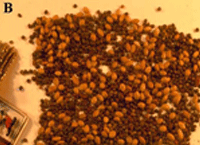
A Native woody species were installed in patches of four varying sizes across an urban landfill. B) Seed traps in each plot were surveyed for number and types of seeds dispersed into each experimental plot by birds and the wind. (Photo: S.N. Handel)
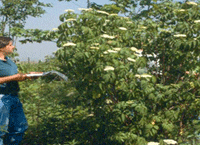
The potential for restoration of habitat must include the ability of pollinators to discover the site, and facilitate production of seed. Test plantings were arrayed across a large landfill, and pollinator identity and visitation numbers were recorded for four years. (Photo: S.N. Handel)
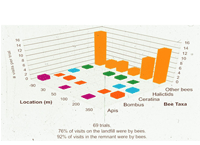
Censusing for bee pollinators at experimental patches of shrubs showed high levels of flower visitation by many species, even 350 meters from the edge of the landfill. The -90m distance represents bee visit density in remnant woodland flanking the site. (Photo: M. E. Yurlina)
"Well done! Intriguing conclusions that provide extremely useful data for the profession, clients, and the public at large. Such a usable resource."
— 2009 Professional Awards Jury
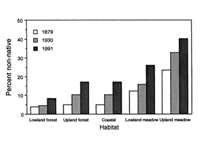
Comparison of floristic surveys in Staten Island, New York across 112 years showed waves of alien plant species in all major habitat types. As these species became more common, historically native species declined. Many of the non-natives became dominant. (Photo: S.N. Handel)
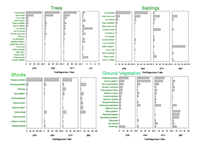
Plant community surveys across 53 yrs at a suburban woodlot show significant change in all plant strata, from canopy trees to herbaceous ground vegetation. Many of the newly common species are aliens that are regional threats to habitat sustainability.(Photo: M. F. J. Aronson)
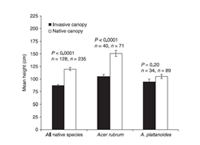
In woodlots where invasive Norway maples dominate the canopy, experimental plantings of tree saplings are significantly suppressed by the presence of invasive, when tested against plantings under native canopy trees. The invasive will have persistent negative impacts on forest development. (Photo: S. L. Galbraith-Kent)
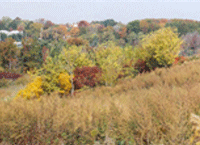
A typical landfill lacks species diversity, habitat value, and ecological services. Mowing creates a sterile visual aspect. B) After installation of habitat patches, native plants spread across the site, attracting birds and mammals, seed dispersal, and the soil becomes enriched. (Photo: S.N. Handel)
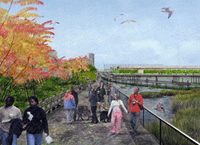
At the Brooklyn Bridge Park in New York City, a series of native habitats, including early successional woodlands, butterfly meadows, and Spartina salt marsh will be added, using plant varieties tolerant of the windy, coastal microclimate. (Michael Van Valkenburgh Associates)
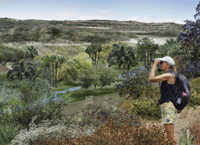
Within the Canyon restored habitats will attract dispersers from surrounding urban remnants, bringing seed of many plants species to complement the palette installed during the construction phases. (Photo: Great Park Design Studio)
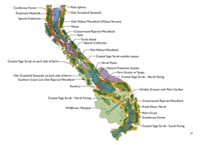
This 5km Canyon landform has a diverse mosaic of native habitat types, using locally adapted seed. The layout is a complex pattern so that adjacent types can expand or contract as the local climate changes over the years. (Photo: Great Park Design Studio)



